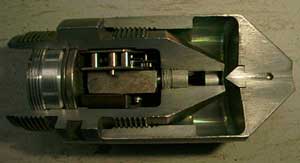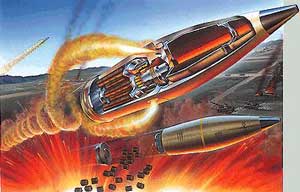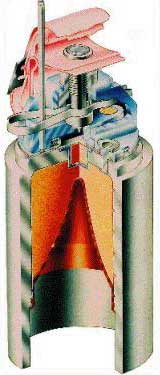 The
production of smart munitions may be jeopardized by
instability in the battery manufacturing sector, Army
officials fear. Although batteries often are not viewed
as critical components, some munitions programs have
been delayed because of battery problems, experts said.
Developers of smart munitions generally turn most of
their attention to the warhead, the guidance system or
the propellant, but not to the batteries.
The
production of smart munitions may be jeopardized by
instability in the battery manufacturing sector, Army
officials fear. Although batteries often are not viewed
as critical components, some munitions programs have
been delayed because of battery problems, experts said.
Developers of smart munitions generally turn most of
their attention to the warhead, the guidance system or
the propellant, but not to the batteries.
The Commerce Department recently
completed an industry study focused on the niche market
for tiny, but complicated batteries that power
munitions, such as artillery rounds. Details of the
report are unavailable, partly because it contains
proprietary data on manufacturers.
"All I can say is that there is
some concern," said Allan Goldberg, a battery program
official at the Army Research Lab- oratory. "You have a
limited industrial base and a limited number of
purchases," he told National Defense Magazine. During
the Vietnam War, he said, the United States was
producing a million artillery batteries a month. Now,
200,000 batteries are considered a "big buy."
For each of the two main types of
munition batteries--liquid electrolyte reserve and
thermal batteries--there are only two or three
manufacturers. According to Goldberg, the only makers of
liquid electrolyte batteries are Alliant Techsystems in
Horsham, Pa., EaglePicher Technologies in Joplin, Mo.,
and KDI Precision Products in Cincinnati, Ohio. For
thermal batteries, the two manufacturers are EaglePicher
and Enser Corp. in Pinellas Park, Fla.
In a presentation to the Institute
for Defense and Government Advancement conference in
Arlington, Va., Goldberg cited two weapons that were
either delayed or could have been delayed because of
difficulties in manufacturing the batteries. One was the
M-234/235 self-destruct fuze for the dual purpose
improved conventional munitions grenades, and the other
is the battery for the Excalibur artillery round.
At the core of the debate is the
state of the industrial base. Turning to commercial
battery giants isn't an option, said Gold
batteries for all of the Defense Department and Energy
Department munitions applications, are a drop in a very
large bucket compared to commercial battery production,
where one company alone makes 4.2 billion batteries a
year."
One problem is the difficulty of manufacturing such
small batteries. Production line nozzles can clog when
forced to rapidly insert minute amounts of electrolyte
into liquid reserve batteries. These components must
have a quick rise time or the ability to generate power
speedily. "Some rounds may not power up when fired. They
may power up [prematurely] when the sub-munitions are
dispersed," Goldberg said.
Goldberg and others are concerned that the current
sales and profit margins will discourage research into
munitions batteries...at a time when munitions are
growing smaller and smarter, thus demanding more power.
The Commerce Department study came about at the
Army's request. It examined a variety of solutions. "One
permissible recommendation is for the government to step
in and take over these companies," said Goldberg.
"The issue is, are we going to have the small
batteries and small power systems these future systems
will need? The direction we are going with our weapons
systems and our requirements would make us believe that
the expectations for power sources are going to be more
difficult to meet."
Some manufacturers aren't quite as pessimistic. Bill
Harsch, director of market and business development for
EaglePicher, said there are "at least two manufacturers
in each of the [battery] chemistries that are very
stable companies."
However, he readily acknowledges that this is a niche
market. "It's only a $20 million business for us," he
said. In contrast, batteries for conventional Army
missiles alone generate $150 million a year for
EaglePicher. The company makes several types of
batteries for defense and space applications.
"I don't know that there is any incentive to enter
the business," Harsch said. "These [munitions] batteries
are a part of our business, but not a large part of our
business. If we were a small startup company, I'd be
concerned about staying in the business. But we've been
in this since 1952."
Because profit margins are small, Harsch sees little
enticement for research and development. "I think the
people involved are very dedicated... But it's a
constant battle to make money, because the technology is
very, very difficult. And they want very low costs.
There has to be to a lot of development in order to
bring these technologies up to the new specifications."
 He
cites problems with the battery for the Army's Excalibur
smart artillery projectile. "There has been an issue
with a rise in voltage rise time. They're really pushing
the envelope of technology. We need to tweak the
design."
He
cites problems with the battery for the Army's Excalibur
smart artillery projectile. "There has been an issue
with a rise in voltage rise time. They're really pushing
the envelope of technology. We need to tweak the
design."
Concerned about the supply of batteries, one fuze
manufacturer produces its own lithium reserve batteries.
KDI manufactures the M234 fuze for the dual-purpose
improved conventional munitions. Batteries aren't its
primary business, but the company found it more
convenient to make its own power source for the M234.
"We make batteries now, because I could not find a
good supplier that met my needs," said Eric Guerrazzi,
president of KDI, which is part of L3 Communications. "I
got into the business totally in self defense, because I
can't deliver fuzes without batteries."
"Everyone who had any expertise in batteries left the
defense market and went to cell phones and computers,"
said Guerrazzi. "Those that are left are scraping by
with no incentive to improve their products."
While Harsch doesn't believe the industry is in bad
shape, he does see areas where government intervention
could help.
 "There
are tax incentive programs they could look at, or of
course just out-and-out better pricing."
"There
are tax incentive programs they could look at, or of
course just out-and-out better pricing."
Munitions batteries come with unique requirements not
found in any other industry. They must be capable of
lying dormant on a shelf for 20 years, and then
discharge their power in a fraction of a second. They
must function in temperatures ranging from minus 45
degrees F to a steamy 145 degrees F, and withstand being
fired out of a cannon that subjects them to as many as
100,000 Gs [the force of gravity].
Batteries that power munitions often are as small as
pencil erasers. The M234/235 self-destruct fuze, used in
the dual-purpose improved conventional munitions
grenades, has the smallest battery in any current U.S.
system. It's only 0.13 cubic centimeters, and consumes
20 to 25 micro- liters of electrolyte. Most munitions
batteries are larger, with the one powering Multi-Option
Fuze for Artillery using 2.5 milliliters in a battery
that is 19 cubic centimeters.
Doug Troast, who leads guidance system development
for the Excalibur, blamed changing requirements rather
than battery problems for delays in the program. He said
Excalibur's designers paid careful attention to
batteries from the start. "If the battery doesn't work,
then nothing else does."
But Goldberg isn't confident that munitions designers
are getting the message. "They have a way of developing
a system and it's pretty well set, and it would take a
radical change of thinking to treat batteries
differently.